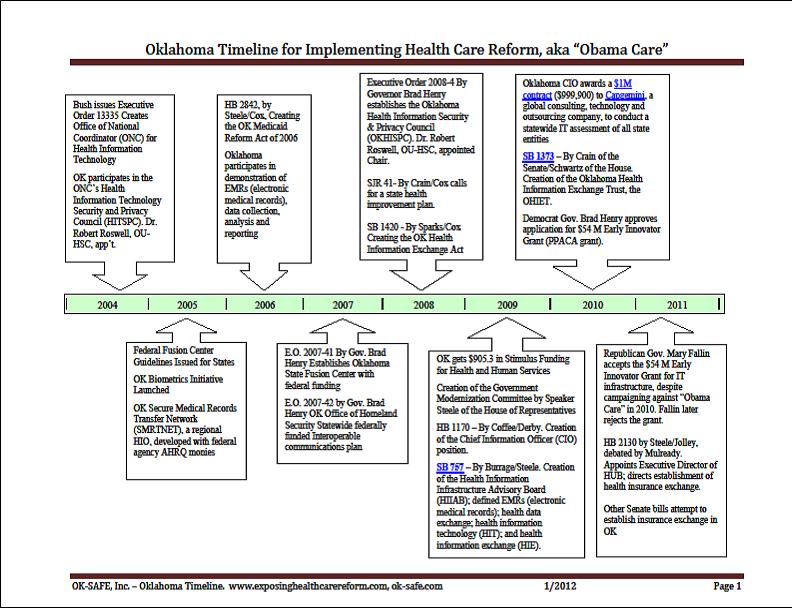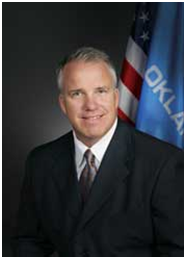|
Oklahoma Timeline for Implementing Health Care Reform,
aka “Obama Care”

Without the knowledge or informed consent of the people, Oklahoma is establishing a universal health care system.
State officials and special interest groups intend to move this state a single-provider, single-payor health care system, requiring a biometric ID card to identify patients. This system transformation demands the adoption and meaningful use of privacy-killing electronic health records (EHRs) on every single person.
These EHRs are to begin at birth, accompany a person all through school and work; track their lifestyle and choices; measure their cost and worth to the state; are globally interoperable; and finally, accessible by the government without a search warrant.
The transformation is primarily taking place in two ways – via legislation and federal grants and is being implemented by state agencies such as the Oklahoma Health Care Authority (OHCA), the OK Dept. of Mental Health and Substance Abuse Services (ODMHSAS), and others, and especially by the incestuous public–beneficiary trust called the Health Information Exchange Trust (OHIET).
Listed below are the laws passed in Oklahoma that are implementing this nightmarish health care system. As bills are found and researched they will be added to the list.
Oklahoma has been in lock-step with the federal efforts to systematically reinvent health care and move toward a single-payer, single-provider, technology-based universal health care system.
Most, if not all, were initiated and run by members of the Republican Party.
The Timeline
2004
- Executive Order 13335 – On April 27, 2004, President Bush issued Executive Order (E.O.) 13335 establishing the position of a National Coordinator for Health Information Technology (IT) within the Office of the Secretary of Health and Human Services. ONC Initiatives include establishing the Nationwide Health Information Network (NHIN), and supporting the development of the Federal Health Architecture. E.O. excerpt: “Incentives for the Use of Health Information Technology and Establishing the Position of the National Health Information Technology Coordinator…The National Coordinator shall, to the extent permitted by law, develop, maintain, and direct the implementation of a strategic plan to guide the nationwide implementation of interoperable health information technology in both the public and private health care sectors…” The ONC has set a goal that every person in the U.S. must utilize an electronic medical record by 2014.
- Oklahoma participates in the ONC's Health Information Technology Security and Privacy Council (HITSPC). Dr. Robert Roswell, OU Health Sciences Center, is appointed. (Roswell, who, per his resume has Top Secret security clearance, has been a constant presence in the effort to bring Oklahoma into alignment with the Office of the National Coordinator's plan to reinvent health care. See 2008 and 2010 details.)
2005
- Federal – Fusion Center Guidelines issued for the states' use to establish fusion centers (data gathering hubs in the states).
- Oklahoma – Secure Medical Records Transfer Network, known as SMRTNET, “became one of Oklahoma's first regional health information organizations (HIOs).” Developed via federal grants from the Agency for Health Care Research and Quality (AHRQ), an agency working with the Office of the National Coordinator (ONC). There are currently seven regional HIOs in Oklahoma.
2006
- HB 2842 – Steele/Cox – Creating the Oklahoma Medicaid Reform Act of 2006. “A. The Oklahoma Health Care Authority shall conduct a needs analysis to design a database of clinical utilization information or electronic medical records for Medicaid providers. This system shall be web-based and allow providers to review on a real-time basis the utilization of Medicaid services including, but not limited to, office visits, inpatient and outpatient hospitalizations, laboratory and pathology services, radiological and other imaging services, dental care, and patterns of dispensing prescription drugs in order to coordinate care and identify potential fraud and abuse.”
- Oklahoma participates in a demonstration project utilizing EMRs (electronic medical records), data collection, analysis and reporting.
2007
- Executive Order 2007–41 by Governor Brad Henry – Oklahoma Information Fusion Center, located at OSBI. Federally funded via $975,000 grant.
- Executive Order 2007–42 – by Governor Brad Henry – Public Safety Interoperability initiative – federally funded via grant.
2008
- Executive Order 2008–4 – By Governor Brad Henry. Establishment of the Oklahoma Health Information Security & Privacy Council (OKHISPC). Dr. Robert Roswell, OU Health Sciences Center, is appointed Chair.
- SJR 41 – By Crain of the Senate/Cox of the House. Called for the State Board of Health to “prepare and return to the Legislature a health improvement plan for Oklahoma”… “through a high functioning public health system.”
- SB 1420 – By Sparks of the Senate/Cox of the House – Creating the OK Health Information Exchange Act. “The State Board of Health shall adopt and distribute a standard authorization form and accompanying instructions for use in obtaining authorization for the exchange of health information.”
- Oklahoma involved in the CMS (Center for Medicare and Medicaid Services) electronic health records demonstration project.
2009
- Federal Stimulus (American Recovery and Reinvestment Act) provides monies to states for health care reform. Called the Real Health Care Reform bill, the Stimulus bill contained the HITECH Act of 2009, providing financial incentives for adoption of electronic health records, and defined their “meaningful use.” Oklahoma accepted $905.3 million in stimulus funding for health and human services.
- Creation of the Government Modernization Committee by the House of Representatives.
- HB 1170 (Text of Bill) – By Coffee of the Senate/Derby of the House. Creation of the Chief Information Officer (CIO) position. CIOs officially recommend states adopt NIEM (National Information Exchange Model) to enable information sharing across boundaries, regardless of jurisdiction.
- SB 757 – By Burrage of the Senate/Steele of the House. Creation of the Health Information Infrastructure Advisory Board (HIIAB); defined EMRs (electronic medical records); health data exchange; health information technology (HIT); and health information exchange (HIE).
2010
- Oklahoma CIO awarded a $1M contract ($999,900) to Capgemini, a global consulting, technology and outsourcing company, to conduct a statewide IT assessment of all state entities, including health care agencies, the Oklahoma Tax Commission, and Public Safety. - Assessment includes As-Is, To-Be, and Roadmap plan.

- SB 1373 – By Crain of the Senate/Schwartz of the House. Creation of the OHIET – “The Oklahoma Health Information Exchange Trust (OHIET) serves as the organizational structure and state designated entity (SDE) for SHIECAP funding and activities. OHIET…will also ensure the state meets future meaningful use requirements and the FULL advancement of HIE (health information exchange) throughout the state.” The purpose of the OHIET Trust is to “establish and maintain a framework for the exchange of health information through a single or multiple health information exchanges, and encourage the widespread adoption and use of EHR system among OK health care providers, payors and patients.” And further, “promote and facilitate the sharing of health information among providers within OK and in other states.”
The OHIET serves as the State Designated Entity (SDE) which can solicit and receive federal grants, loans, contributions, or appropriations from any public or private source and award contracts. The OHIET operates will virtually no oversight. [See The OHIET on the Exposing Health Care Reform site for more details.]
The OHIET works closely with the state's Regional Extension Center (REC), Beacon Community, and other HIOs, and the state's broadband initiative to promote future HIE activities and meet ONCHIT goals. [See p. 5 OHIET Strategic Plan .]
- Oklahoma is awarded a $1M State Planning and Establishment Grant for the Affordable Care's Exchanges. (An “Obama Care” grant).
- The Office of State Finance is awarded a $74M Oklahoma Community Anchor Network (OCAN) grant to make broadband available in “rural and underserved communities” across the state. Primary beneficiaries are OneNet, the Oklahoma State Regents for Higher Learning, and the OK Dept. of Transportation. “OCAN plans to construct 1,000 miles of new fiber to almost double the existing fiber in the OneNet network. OCAN plans to construct 1,000 miles of new fiber to almost double the existing fiber in the OneNet network, and provide direct connections to vital community organizations like Southeastern Oklahoma State University, Western Oklahoma State College, Lawton Indian Hospital's Indian Health Services Unit, and the state's Council on Law Enforcement Education and Training location. Improved broadband services for these organizations will greatly enhance education, public safety, and healthcare opportunities in the region.”
- Democrat Governor Brad Henry administration applies for the $54 M Early Innovator Grant to fund the development of the Technological Infrastructure for Health Information/Insurance Exchange in Oklahoma. (A PPACA grant, the Early Innovator Grant clearly stated it was part of “Obama Care.”)
2011
- In February 2011 Republican Governor Mary Fallin announced the acceptance of the $54 M Early Innovator Grant for IT infrastructure, including for the exchange, despite campaigning against “Obama Care” in 2010. In April Fallin rejected the Early Innovator Grant, due to political pushback.

Gov. Fallin (R) with Chinese official, April 2011
- HB 2130 – By Steele and McCullough of the House/Jolley of the Senate. This bill was to have established the Secretary of Health and Human Services (Dr. Terry Cline) as the Executive Director of the Health Care for the Uninsured Board (HUB) to oversee the establishment of a Health Insurance Exchange in the state of Oklahoma. The HUB was to be funded via federal grants.

Mulready
- Freshman legislator Rep. Glen Mulready presented HB 2130 for Speaker/Author Kris Steele. An insurance agent, Mulready was elected in 2010 to HD 68 in Tulsa. Blue Cross/Blue Shield contributed $5,000 to his campaign.) The bill narrowly passed by the House on March 17, 2011. House leadership used extraordinary means to assure the passage of this controversial bill, waiting until the necessary 51 required votes were achieved. (House Video archive of 3/17/11; HB 2130 debate and vote is viewable from minute marker 06:25:00 to 07:32:53.)
- State fusion centers, always a federal initiative, announce they are going federal. Information available to fusion centers now includes public health information, i.e. medical records.
- Executive Order 2011-39 issued August 31, 2011 by Governor Mary Fallin. “The Oklahoma Office of Homeland Security is charged with providing oversight of The Oklahoma Information Fusion Center (“OIFC”) by creating a Governance Board. The Oklahoma State Bureau of Investigation (“OSBI”) will manage the day to day operations of the OIFC. The Oklahoma Office of Homeland Security and the OSBI will work together to ensure OIFC meets the criteria set by the United States Department of Homeland Security for state fusion centers.”
As other state initiatives are identified and researched they will be added to this timeline.
|